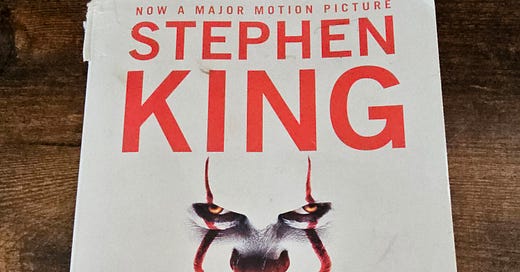Writing Skins is a reader supported author newsletter that shares excerpts from an award nominated speculative fiction writer’s craft journals. It offers a vulnerable, funny, and interesting look at the writing life, craft, and storytelling.
Craft Chat is the writing craft section of the newsletter where subscribers and me go through a subject, piece of media, or technique together.
Heart thudding in his chest like the hard measured strides of a soldier’s boots, he reached the edge and looked down.
Nestled in the cellarhold, the bird looked up.
Mike was not at first sure what he was seeing. All the nerves and pathways in his body seemed frozen, including those which conducted thoughts…
Then the ground suddenly began to shift and run out from beneath his feet… With a yell he threw himself backward, pinwheeling his arms for balance. He lost it and thumped heavily to the littered ground… He scrambled to his knees, crawled, looked back over his shoulder, and saw it rising out of the cellarhold.
- (Stephen King ‘It’)
All of It is filled with tension and terror from the idea (a murderous other worldly entity dressed like a clown kills people, mostly children, in a small town to feed off the fear and anger) to the structure (a story told in bending flashbacks where hundreds of pages can pass but the story itself won’t move anywhere but backwards) and to the character development (the characters’ pasts are hidden from them but are slowly revealed to the reader as the character remembers it).
But the tenson that does most of the heavy lifting is in King’s sentences.
A couple years back, I came across the term micro tension which I believed at the time had to do with the micro elements in fiction that build tension, like the words we use and the sentence structure and word placement, punctuation, and other forms like footnotes and interludes. When I read the definition even now, I have the same feeling and belief of micro tension. Micro tension is defined as the tension in the incremental moments of a scene, which for me translates to the tension that happens in the sentences.
In the scene excerpted above from It, King uses micro tension to propel the reader through the passage because he holds off on telling you what is happening, and you don’t know what the next sentence will hold. And it goes on in that scene for several pages. Never letting up and creating a heart pounding scene. He does it again and again throughout the book without it getting old (though it does get exhausting).
“He whirled around, now pressing his back and his splayed hands against the door. He could feel sweat, oily and hot, running down his forehead. The calliope music had gotten louder yet. It drifted and echoed down the spiral staircase…It screamed like wind and water, and in his mind’s eye Stan saw a county fair at the end of autumn, wind and rain blowing up a deserted midway, pennons flapping, tents bulging, falling over, wheeling away like canvas bats.” (It)
The introduction of circus music during this scene where a child appears to be afraid creates the micro tension and builds to the big tension of the story and moment in the book. Words like ‘screamed’ ‘deserted’ ‘bats’ create a distance between what we normally associate with circuses (happiness and joy and cheer) with something terrifying and slightly off, adding to the micro tension. And instead of saying outright that there is creepy music playing, King strings it out.
In this section of the book as in many others, a child is seeing a creature that by all reason shouldn’t exist and feels absolutely terrified. King puts us into the child’s untied shoes to experience the flight and fight the child must do to survive.
“As it flew at him, swooping down, its black, horribly alive eyes fixed on him, Mike cut sharply right. The bird missed him—barely. The dusty smell of its wings was overpowering, unbearable.
Now he was running parallel to the fallen smokestack, its tiles blurring by. He could see where it ended. If he could reach the end and buttonhook to the left, get inside, he might be sage. He thought the bird was too big to squeeze inside. He came very close to not making it.” (It)
See how slow the approach is, how short some of the sentences are, how quickly the words run as the child flees. And the feelings aren’t described in that section because they are shown through how the child runs. We are totally present in the tension of the moment through the micro tension King employs.


